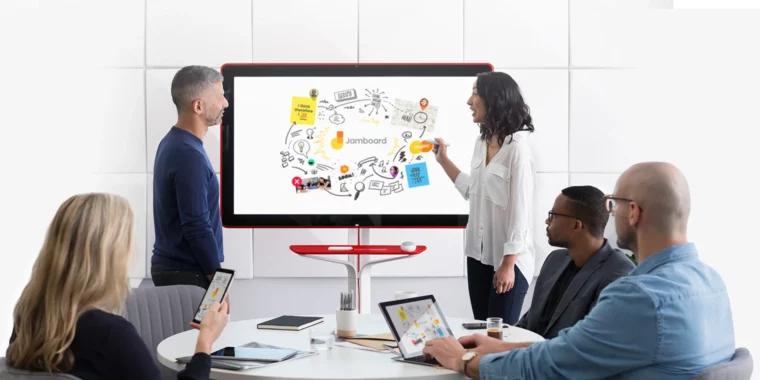
-
The Google Jamboard was a big, red touchscreen.
-
$5,000 for the screen, plus an optional $1,349 for the rolling stand (you can also wall-mount it).
-
It came in three colors.
-
The pricing at launch.
Even more Google products are getting the ax this week. Next up is Google Jamboard, a $5,000 digital whiteboard (and its $600-a-year fee) and software ecosystem marketed to schools and corporations. Google has a new post detailing the “Next phase of digital whiteboarding for Google Workspace,” and the future for Jamboard is that there is no future. In “late 2024,” the whole project will shut down, and we don’t just mean the hardware will stop being for sale; the cloud-based apps will stop working, too.
Most people probably haven’t ever heard of Jamboard, but this was a giant 55-inch, 4K touchscreen on a rolling stand that launched in 2016. Like most Google touchscreens, this ran Android with a locked-down custom interface on top instead of the usual phone interface. The digital whiteboard could be drawn on using the included stylus or your fingers, and it even came with a big plastic “eraser” that would remove items. The SoC was an Nvidia Jetson TX1 (a quad-core Cortex-A57 CPU attached to a beefy Maxwell GPU), and it had a built-in camera, microphone, and speakers for video calls. There was HDMI input and Google cast support, and it came in whimsical colors like red, gray, and blue (it feels like Google was going for an iMac rainbow and quit halfway).
Google’s secret sauce here was that Jamboard was heavily integrated with Google Workspace, so it could pull in items from Google Docs, Sheets, and Slides, and all your whiteboard work was saved in a filetype called “Jams” in the usual Google storage. Like the other Workspace apps, this all worked live over the Internet. People not in front of the touchscreen could launch the “Jamboard app” instead, letting them get in on the whiteboard action remotely, complete with live handwriting.
On the death of its latest product, Google says, “We’re grateful to the consumers, educators, students, and businesses who have used Jamboard since its launch in 2016. While Jamboard users make up a small portion of our Workspace customer base, we understand that this change will impact some of you, and we’re committed to helping you transition…” Yes, that’s right, “transition” is usually not something you have to consider when a company kills a hardware product, but the whole cloud system is going down, too, so all of your existing $5,000 whiteboards will soon be useless, and you won’t be able to open the cloud data on other devices.
“Over the coming months, we’ll provide Jamboard app users and admins clear paths to retain their Jamboard data or migrate it,” Google tells users in its blog post. The migration options are all third-party competitor whiteboard apps—Figma’s FigJam, Lucid Software’s Lucidspark, and Miro. Google says you can move your data in “just a few clicks, well before the Jamboard app winds down in late 2024.” Going forward, Google says it has “decided to leverage our partner ecosystem for whiteboarding in Workspace,” meaning exiting the whiteboard market, showing users the door, and telling them to take their data with them.
You’ll still need a new touchscreen, which means another pricey hardware purchase for existing Jamboard customers. Google seems to feel particularly bad for the schools that bought into this, saying, “We will also work directly with educational institutions to compensate them for their Jamboard devices.“
Jamboard was a pricey item, but $5,000 was just the tip of the iceberg. There was a $600 “annual management and support fee,” plus subscriptions to Google Workspace for every user, plus an optional $1,350 for the rolling stand. A one-year total with a single Workspace user is around $7,000. People often ask about a recurring revenue stream when predicting what products will live and die, but even a $600-per-year fee attached to every sale wasn’t enough to keep Jamboard running.
https://arstechnica.com/?p=1972006

